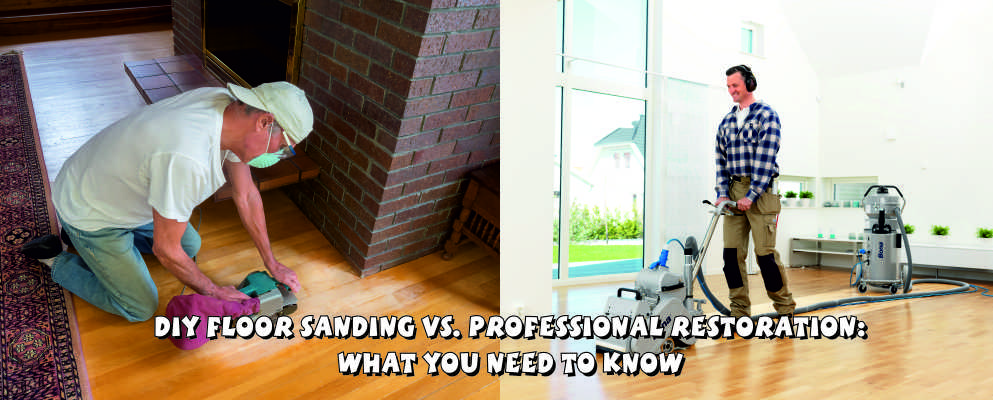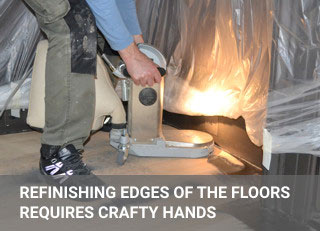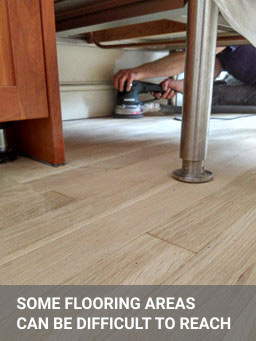Back to DIY Advice
DIY Floor Sanding vs. Professional Restoration: What You Need to Know

Restoring the beauty of your wooden floors through sanding can make a dramatic difference to your home’s appearance. But one of the first decisions you’ll need to make is whether to take the DIY route or hire a professional floor sanding company.
At first glance, doing it yourself may seem like the cheaper and more flexible option. On the other hand, professionals offer experience, commercial-grade equipment, and results that are often hard to match. So, which one is right for your situation?
In this guide, we’ll break down the pros and cons of both DIY floor sanding and hiring a professional, compare costs, and help you decide which path leads to the best outcome for your floors and your peace of mind.
What is Floor Sanding?
Floor sanding is the process of removing the top surface of a wooden floor using abrasive materials to reveal a smooth, fresh layer beneath. It's typically used to eliminate old finishes, scratches, stains, and imperfections in preparation for refinishing with oils, lacquers, or sealants.
The process generally involves three key stages: rough sanding to remove old finishes, medium sanding to flatten and level the boards, and fine sanding to smooth the surface before finishing. It can be applied to various types of wood flooring, including solid wood and engineered boards (depending on their top layer thickness).
For more information, visit our guide to wood floor sanding and restoration.
The DIY Floor Sanding Route
Choosing to sand your wooden floors yourself can be tempting, especially if you're looking to save money or enjoy the satisfaction of a hands-on home improvement project. While it’s certainly doable, there are several important factors to weigh before renting a machine and getting started.
Advantages of DIY Floor Sanding
- Lower upfront cost: You’ll avoid labour charges and can shop around for affordable equipment rentals and supplies.
- Flexibility: You control the schedule and pace of the project, which can be helpful for weekend renovations.
- Personal satisfaction: Completing the job yourself can be rewarding and educational.
Disadvantages of DIY Floor Sanding
- Steep learning curve: Sanding machines are powerful and difficult to control without prior experience, increasing the risk of uneven results or damage to your floor.
- Risk of mistakes: Common DIY errors include oversanding, creating drum marks, missing edges, or uneven finishes. Learn more in our guide to common DIY floor sanding mistakes.
- Time-consuming: DIY sanding can take two to three times longer than a professional job, especially if you encounter issues or lack the proper tools.
- Limited equipment quality: Rental machines are often less efficient and more worn than the professional-grade, dust-free systems used by floor sanding companies.
DIY may be suitable for small, low-risk areas or if you're experienced with heavy tools, but for larger spaces or valuable floors, the risks often outweigh the savings.

Hiring a Professional Floor Sanding Company
When it comes to achieving flawless, long-lasting results, hiring a professional floor sanding company is the safest and most efficient option. Experienced teams come equipped with the right tools, knowledge, and techniques to handle various types of wood flooring and challenges.
Advantages of Hiring a Professional
- High-quality finish: Professionals use industrial-grade sanding machines and premium finishing products to ensure an even, smooth, and durable result.
- Dust-free sanding: Most modern companies use dust containment systems, which drastically reduce airborne dust and keep your home cleaner during the process.
- Time-saving: What could take a DIYer several days, professionals often complete in one or two, depending on the size of the project.
- Expertise and repair skills: Pros can fix damaged boards, fill gaps, and choose the right sanding sequence to preserve the life of your flooring.
- Guaranteed results: Most reputable companies offer warranties or satisfaction guarantees, giving you peace of mind.
Disadvantages of Hiring a Professional
- Higher initial cost: Hiring a professional service comes with labour and service fees, which may seem costly compared to DIY.
- Scheduling required: You’ll need to coordinate dates with the company, which might require some flexibility.
To learn more about what’s included, see our professional floor restoration services page for details.
Cost Comparison
One of the most common reasons homeowners consider DIY floor sanding is the potential cost savings. However, it's important to compare the true expenses — including tools, time, and risk — before deciding which route offers the best value.
DIY Floor Sanding Costs
- Equipment rental: Drum sander, edge sander, and vacuum rentals typically cost £50–£100 per day.
- Abrasives & finishes: Sandpaper, wood filler, stains, and lacquers can add another £50–£150, depending on floor size and product quality.
- Time investment: DIY projects often take 2–3 times longer than professional work, adding stress, especially in homes with children or pets.
- Risk of mistakes: Uneven sanding or damage may require professional rescue work, which doubles your overall cost.
Professional Floor Sanding Costs
- Standard rates: Professional sanding typically costs between £20–£30 per square metre, depending on the condition of the floor and the finish chosen.
- All-inclusive service: This usually includes dust-free sanding, staining, sealing, and minor repairs — plus professional advice tailored to your floor type.
- Long-term value: With a high-quality, long-lasting finish, you’re less likely to need touch-ups or early refinishing.
While DIY may seem cheaper upfront, the hidden costs of time, risk, and potential repair work often make professional floor sanding a better long-term investment, especially for large or high-value spaces.
When Should You DIY?
DIY floor sanding can be a practical choice for certain situations, especially if you’re confident with tools and working on a small-scale project. Here are some scenarios where the DIY route might be appropriate:
- Small rooms: Bedrooms, home offices, or closets with straightforward layouts are ideal for beginners.
- Low-risk flooring: If you're working with inexpensive or already damaged floors, mistakes are less costly.
- Previous experience: If you’ve used sanding equipment before, you’ll be more comfortable with the process and better equipped to manage the details.
- Budget constraints: For those with time but limited funds, DIY may be the only feasible option.
- No urgency: If you can dedicate several days without pressure, a slow-paced DIY job could still yield acceptable results.
Keep in mind, though, that even in these cases, it's worth learning about common mistakes to avoid costly errors before you begin.
When Should You Hire a Professional?

For many homeowners, hiring a professional floor sanding company is the safest and most practical choice, especially when the stakes are high. If any of the following apply to your situation, professional help is strongly recommended:
- Large or open-plan spaces: Wide areas require experience and precision to achieve a consistent finish without visible sanding marks or lines.
- Valuable or historic flooring: Antique or premium hardwood floors are too valuable to risk with DIY tools or trial-and-error techniques.
- Time-sensitive renovations: If you're preparing a home for sale or dealing with a tight renovation schedule, professionals complete the job efficiently and to a high standard.
- High expectations for finish quality: When you're aiming for showroom-level results, expert sanding and finishing are hard to beat.
- Uneven or damaged floors: Professional companies can address boards that are cupped, warped, or previously refinished unevenly.
For reliable results, explore our professional floor sanding services, trusted across London for over 20 years.
Frequently Asked Questions
How long does DIY floor sanding take?
A typical DIY project for one room can take anywhere from 2 to 4 days, depending on your experience, the equipment used, and the floor’s condition. Professionals can usually complete the same job in 1 to 2 days.
What are the most common mistakes in DIY sanding?
The biggest DIY errors include oversanding, gouging the floor with the drum sander, missing edges, and uneven application of finish. These can be costly and may require professional repair.
Do professionals use better equipment?
Yes. Professional floor sanding companies use high-powered, dust-free machines that offer smoother, more consistent results and reduce mess in your home.
Is it worth hiring a professional for small rooms?
If the floor is valuable or you want a flawless finish, hiring a pro is still worth it. However, for small rooms with low-risk flooring, DIY can be cost-effective — if done carefully.
Can I rent the same machines professionals use?
Not quite. Rental machines are often less powerful and less maintained than those used by professional sanding teams. This can impact both the quality of the sanding and the finish.